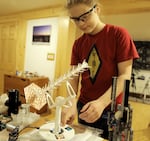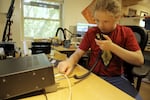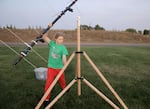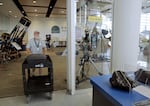
Zeke Wheeler, 13, demonstrates one of the tabletop satellite antennas he's working with in Portland, Oregon on Sept. 30, 2024.
Kristian Foden-Vencil / OPB
The basement of Zeke Wheeler’s house in Southwest Portland is a young scientist’s dream. The 13-year-old has computers, soldering irons, magnifying glasses, remote-controlled airplanes, a 3D printer and a couple of amateur radios.
On a recent afternoon, the homeschooled eighth grader talked into a handset: “This Kilo Juliet Seven November Lima Lima.”
He was working to ping his ham radio signal off the International Space Station and find other ham operators doing the same thing.
“Every time I make contact with a new person, I put a pin in,” Wheeler said, pointing to a large map of the United States above his desk. “I’ve talked to people as far away as Nashville.”

Zeke Wheeler on his ham radio in his basement in SW Portland. Sept. 30, 2024
Kristian Foden-Vencil / OPB
The teenager has been fascinated with science and technology for as long as he can remember. As a toddler, he made a simple circuit with his father, a computer consultant. It included a lightbulb, a battery and a switch, and he would flick the machine on and off repeatedly, sharing the wonder with anyone who cared to notice.
When he was 8, he began wondering if he could find a way to talk to the people floating above him in space.
“I didn’t know how to do that,” he said. “So I asked my dad how to contact an astronaut on the International Space Station.”
Eric Wheeler didn’t know either, so he sent his young son on a computer search. The boy found that the ISS actually has a ham radio. All he needed to do to contact the station was the means, so he worked to get a ham radio license with the help of his father and grandfather.
“We all took the class, and I didn’t pass the first time,” he said. “But then I studied really hard and then I got it the third time, with a higher score than my dad.”
He started trying to contact the space station. But the astronauts aren’t sitting by that ham radio waiting for arbitrary calls from the public. So Wheeler hit the internet again and found ARISS, Amateur Radio on the International Space Station, an organization that links students with astronauts to inspire them to pursue careers in science.
Following ARISS and NASA suggestions, Wheeler secured a sponsor, a second ham radio — in case the first one broke — and linked in his online school, TEACH-NW, for help building a special antenna he designed.
“I think what makes it special is that he has the curiosity and then the drive to follow it, which you kind of need both to really go far like this,” said Kori Dunn, Wheeler’s education facilitator.
Wheeler’s classmates voted on what questions to ask, things like: What research is being conducted? What is it like to live in space?
Dunn said NASA asked for a few parameters around the questions.
“They ask that it at least lean educational,” she said. “If it’s something incredibly easy to Google search, don’t pick those questions. And then just making sure it’s respectful and appropriate.”

Zeke Wheeler, 13, installs an antenna at the Evergreen Aviation Museum in McMinnville, Oregon, on Sept. 24, 2024. Wheeler designed the antenna to contact the International Space Station orbiting the Earth.
Kristian Foden-Vencil / OPB
On a recent evening, amateur astronomers with the Carlton Observatory in McMinnville set up telescopes for their weekly star-watching party.
They’re sponsoring Wheeler because he needs access to the large grassy area outside the Evergreen Aviation & Space Museum. With few buildings, the Yamhill County campus is a good spot with a wide open sky and, hence, clear contact with the space station. That’s essential; the space station travels at 17,500 miles an hour, giving Wheeler just 10 minutes for a conversation.
Observatory co-founder Forrest Babcock said he sees himself in the young man. He remembers cobbling together a transformer with copper wire and nails when he was young.
“He’s a modern example of how I was in the 1960s. But he has 2020 technology,” Babcock said. “He’s an amazing young man.”

Forrest Babcock rolls out telescope parts for a star party outside the Carlton Observatory in McMinnville, Sept. 24, 2024 “(Zeke) is a modern example of how I was in the 1960s. But he has 2020 technology,” said Babcock. “He’s an amazing young man.”
Kristian Foden-Vencil / OPB
That may be true, but there’s a twist to Wheeler’s story,
“I don’t actually want to talk to an astronaut,” he said. “I have a list of questions if I happen to get them. But I want to be the medium to make it possible for others to talk.”
Wheeler plans to set everything up and then emcee the conversation, letting his friends ask the questions. For him, it’s all about the science.
“I like to overcome challenges,” he said. “What really motivates me is getting a result that will work.”
The public can listen to the conversation at the Evergreen Aviation & Space Museum at 11:30 a.m. on Friday, Oct. 18.
